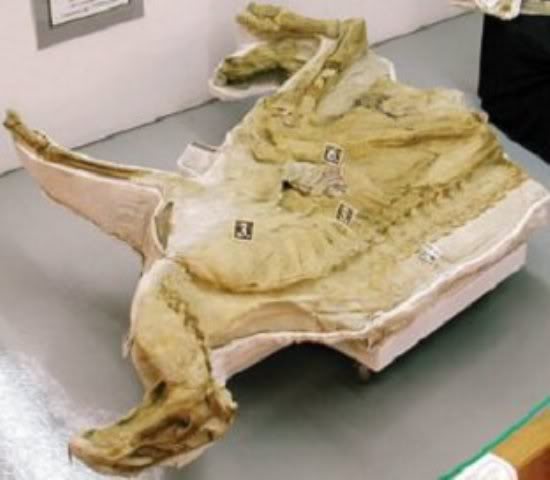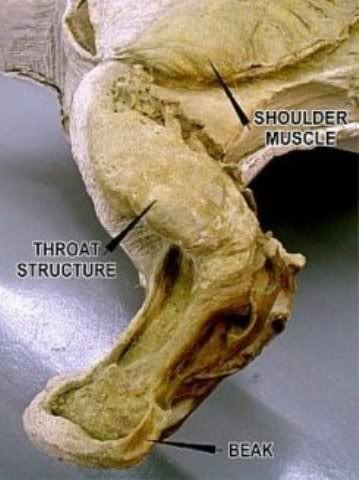This is a Fantastic discovery, irregardless of debating.
(Duck-Billed Dinosaur)
Great Falls Tribune
STREAMING VIDEO LINK
MALTA (Montana) The absolute latest in technology is helping solve a forensics mystery that is 77 million years old. Five years ago in the badlands north of Malta, paleontologists uncovered a mummified duck-billed brachylophosauruses so well preserved that much of its skin and soft tissue parts remained along with its skeleton.




In the years since, scientists have wondered if the skin was still there, what about its organs and tissues inside? Technology has finally advanced enough to take a peek. And this week, 20 experts in various fields are X-raying and photographing Leonardo the dinosaur, even parts buried beneath thick sandstone.
"This specimen could be as important to the field of paleontology as the day Neil Armstrong set foot on the moon," said Nate Murphy, curator of paleontology at the Judith River Dinosaur Institute.
With just one of at least three days of X-raying complete, Murphy wasn't ready Tuesday to reveal the secrets Leonardo was whispering. But the potential is amazing.
His stomach was filled with the fossilized pollen from 33 types of plants, enabling the paleontologists to recreate the world 77 million years ago.
Tuesday morning the scientists looked at the keratin forming Leonardo's beak, which, like cartilage, is usually dissolved in time.
Bob Bakker, whose theory that dinosaurs were warm-blooded revolutionized and invigorated the field, was on hand in Malta to analyze the recorded images. He noticed that Leonardo's nose was incredibly hard and sharp, indicating that he used it like a machete to cut leafy branches off trees. "For 130 years, we paleontologists have had a case of veggiecide," he said. "We suspected these dinosaurs were plant-eaters, but we didn't have the smoking jaws, the smoking gut."
Much of Leonardo remains covered in rock, to protect the fossilized skin, fragile tissues and bones. Until now, the technology didn't exist to look at what was beneath the sandstone.
Starting Monday, scientists and industry leaders donated their time and equipment to advance the study. Over the next 20 months, the Discovery Channel is filming the process for an extensive documentary. Non-Destructive Testing Group shipped in more than 600 pounds of X-ray equipment for the scans. The Michigan-based company normally uses the equipment for industrial purposes, like checking vehicles' steering controls for safety flaws. CEO Bob Bills said this is the first time it's been used to look at dinosaurs. The rays emit as much as 300 kilovolts on Leonardo. Each time the X-ray was used, the scientists evacuated the building, which was roped off as radiation reaches 30 feet beyond the steel walls.
Because the rays only damage living tissue, Leonardo's fragile remains will be completely unharmed.
The X-rays were combined with advanced imaging technology from Eastman Kodak that is 10 times as sensitive as film. In one shot, the plate collected the same images that would take dozens of cameras shooting different speeds of film to capture. The computer then sifts through the layers of data, and for that matter sandstone, skin and bone, to Leonardo's insides.
"We might not have to uncover any more to see what's in there," said Kodak's Steve Mango. "Of course, Nate and Dr. Bakker were a lot more excited because they know what they're seeing."
The pair of paleontologists excitedly pointed at the black and gray blobs on the screen at what looked like an enlarged row of TicTacs lying on a mesh-like net. The images showed the top of Leonardo's vertebrae and the soft tissue that is buried under a layer of rock.
"This is really interesting," Murphy said, leaning to get a closer look at the computer screen.
"Oh! I can see it," Bakker exclaimed pointing.
"It looks so soft," Murphy said. "The images are getting clearer and clearer and we're seeing odd things."
One of the most important things discovered so far are half-inch specks that Bakker is jokingly calling blebs. Blebs are basically iron deposits left behind by bacteria. The blebs are randomly spread throughout Leonardo's insides, and nowhere on the outside.
"This is telling us we have a hermetically sealed sarcophagus," Murphy said.
The evidence goes a long way to justify what many paleontologists are having a hard time believing that Leonardo is as well preserved as Murphy says it is and how, after millions of years, that is even possible.
Beyond the blebs, Bakker is most interested in studying Leonardo's stomach and digestive system and his unusually long arms.
Unlike most Brachylophosauruses, his arms were long enough to touch the ground, but the joints weren't strong enough to support the dinosaur's weight. Bakker theorizes that the arms may have been used to communicate with a wave or a dance. Or perhaps its fingers were sensitive enough to pick up sound waves from the ground, allowing the creatures to communicate with others miles away by stomping.
In October, Murphy plans to present his findings at a medical imaging conference in Houston. Before that, other tests will be done. In September, scientists will be back to use an element scan to break down each type of atom in the bones and the dirt around them.
Art Andersen, an imaging specialist with Virtual Services Inc., said the scans could be used to examine forensic evidence that normally was removed to get to the bone. That dirt could show the outline of flesh and muscles, helping better piece together what dinosaurs looked like. Murphy hopes the studies will build interest and funding for more tests particularly CT scans that could take three-dimensional images instead of the one-dimensional pictures captured in the X-rays this week. "A long, long time after I'm pushing up daisies, scientists will be learning from this specimen," he said.
+
(Duck-Billed Dinosaur)
Great Falls Tribune
STREAMING VIDEO LINK
MALTA (Montana) The absolute latest in technology is helping solve a forensics mystery that is 77 million years old. Five years ago in the badlands north of Malta, paleontologists uncovered a mummified duck-billed brachylophosauruses so well preserved that much of its skin and soft tissue parts remained along with its skeleton.


In the years since, scientists have wondered if the skin was still there, what about its organs and tissues inside? Technology has finally advanced enough to take a peek. And this week, 20 experts in various fields are X-raying and photographing Leonardo the dinosaur, even parts buried beneath thick sandstone.
"This specimen could be as important to the field of paleontology as the day Neil Armstrong set foot on the moon," said Nate Murphy, curator of paleontology at the Judith River Dinosaur Institute.
With just one of at least three days of X-raying complete, Murphy wasn't ready Tuesday to reveal the secrets Leonardo was whispering. But the potential is amazing.
His stomach was filled with the fossilized pollen from 33 types of plants, enabling the paleontologists to recreate the world 77 million years ago.
Tuesday morning the scientists looked at the keratin forming Leonardo's beak, which, like cartilage, is usually dissolved in time.
Bob Bakker, whose theory that dinosaurs were warm-blooded revolutionized and invigorated the field, was on hand in Malta to analyze the recorded images. He noticed that Leonardo's nose was incredibly hard and sharp, indicating that he used it like a machete to cut leafy branches off trees. "For 130 years, we paleontologists have had a case of veggiecide," he said. "We suspected these dinosaurs were plant-eaters, but we didn't have the smoking jaws, the smoking gut."
Much of Leonardo remains covered in rock, to protect the fossilized skin, fragile tissues and bones. Until now, the technology didn't exist to look at what was beneath the sandstone.
Starting Monday, scientists and industry leaders donated their time and equipment to advance the study. Over the next 20 months, the Discovery Channel is filming the process for an extensive documentary. Non-Destructive Testing Group shipped in more than 600 pounds of X-ray equipment for the scans. The Michigan-based company normally uses the equipment for industrial purposes, like checking vehicles' steering controls for safety flaws. CEO Bob Bills said this is the first time it's been used to look at dinosaurs. The rays emit as much as 300 kilovolts on Leonardo. Each time the X-ray was used, the scientists evacuated the building, which was roped off as radiation reaches 30 feet beyond the steel walls.
Because the rays only damage living tissue, Leonardo's fragile remains will be completely unharmed.
The X-rays were combined with advanced imaging technology from Eastman Kodak that is 10 times as sensitive as film. In one shot, the plate collected the same images that would take dozens of cameras shooting different speeds of film to capture. The computer then sifts through the layers of data, and for that matter sandstone, skin and bone, to Leonardo's insides.
"We might not have to uncover any more to see what's in there," said Kodak's Steve Mango. "Of course, Nate and Dr. Bakker were a lot more excited because they know what they're seeing."
The pair of paleontologists excitedly pointed at the black and gray blobs on the screen at what looked like an enlarged row of TicTacs lying on a mesh-like net. The images showed the top of Leonardo's vertebrae and the soft tissue that is buried under a layer of rock.
"This is really interesting," Murphy said, leaning to get a closer look at the computer screen.
"Oh! I can see it," Bakker exclaimed pointing.
"It looks so soft," Murphy said. "The images are getting clearer and clearer and we're seeing odd things."
One of the most important things discovered so far are half-inch specks that Bakker is jokingly calling blebs. Blebs are basically iron deposits left behind by bacteria. The blebs are randomly spread throughout Leonardo's insides, and nowhere on the outside.
"This is telling us we have a hermetically sealed sarcophagus," Murphy said.
The evidence goes a long way to justify what many paleontologists are having a hard time believing that Leonardo is as well preserved as Murphy says it is and how, after millions of years, that is even possible.
Beyond the blebs, Bakker is most interested in studying Leonardo's stomach and digestive system and his unusually long arms.
Unlike most Brachylophosauruses, his arms were long enough to touch the ground, but the joints weren't strong enough to support the dinosaur's weight. Bakker theorizes that the arms may have been used to communicate with a wave or a dance. Or perhaps its fingers were sensitive enough to pick up sound waves from the ground, allowing the creatures to communicate with others miles away by stomping.
In October, Murphy plans to present his findings at a medical imaging conference in Houston. Before that, other tests will be done. In September, scientists will be back to use an element scan to break down each type of atom in the bones and the dirt around them.
Art Andersen, an imaging specialist with Virtual Services Inc., said the scans could be used to examine forensic evidence that normally was removed to get to the bone. That dirt could show the outline of flesh and muscles, helping better piece together what dinosaurs looked like. Murphy hopes the studies will build interest and funding for more tests particularly CT scans that could take three-dimensional images instead of the one-dimensional pictures captured in the X-rays this week. "A long, long time after I'm pushing up daisies, scientists will be learning from this specimen," he said.
+
